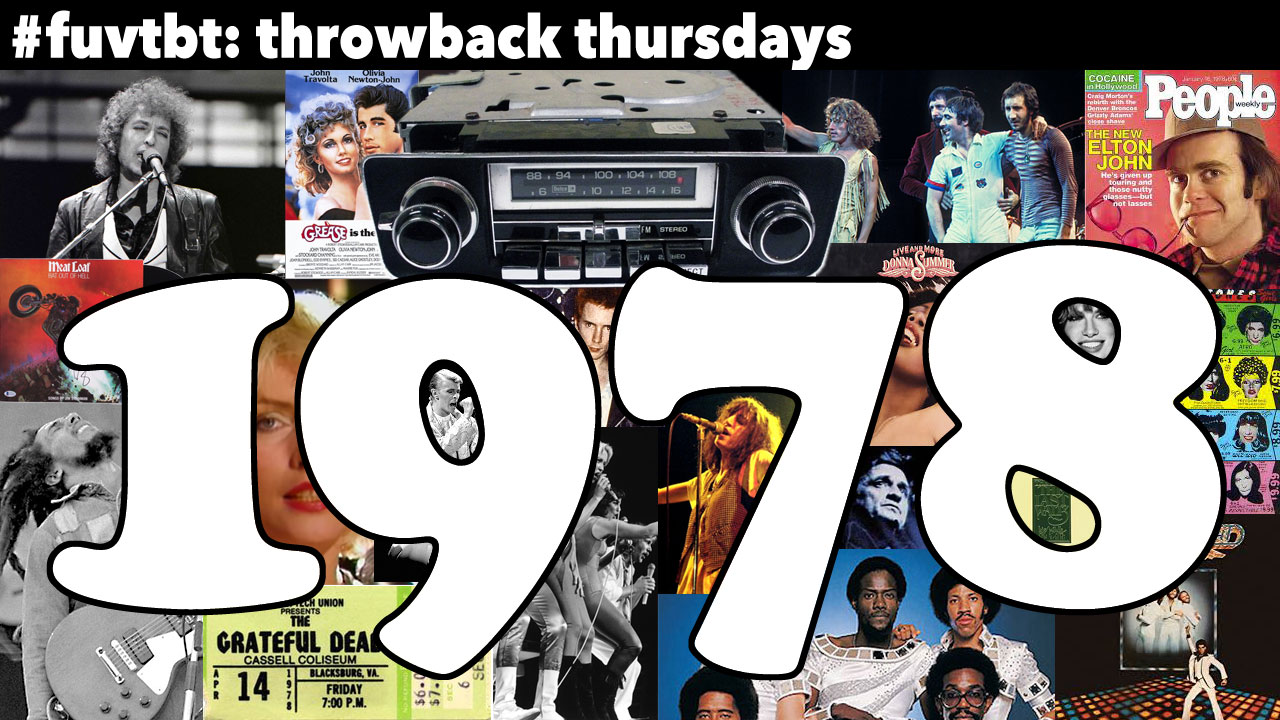The Essential Music of 1978

1978 (collage compiled by Laura Fedele, WFUV)
For the last four Thursdays of the summer of 2018, it's #FUVTBT Throwback Thursdays. WFUV is rewinding decades, back to 1998, 1988, 1978, and 1968 — dipping back for day-long flashbacks with songs of that particular year and personal perspectives from FUV's DJs. For 1978, FUV's Paul Cavalconte, host of "Cavalcade," goes back forty years to a high school summer when Debbie Harry, Donna Summer, and the Ramones were on the radio and made New Yorkers dance, rock, and rave.
1978 was the year that awakened me to the reality of extremes, a world of polar opposite boundaries. A crippling blizzard in February was bookended by stifling heat in August. The throb of disco was offset by the grind of punk. Big screen grandeur came in the form of "Superman," "The Deer Hunter," and "Heaven Can Wait" while little screen compactness showcased the escapism of "Dallas," "Taxi," and the seminal real-people soap opera, "Family." And in the private universe of my own 17-year-old brain, moment-by-moment turmoil was the existential mindset. Of course I was the first human being to experience this jumble of conflicts and urges in the history of ever. But as Gloria Gaynor testified on every transistor radio, I would survive.
1978's fractured music was a perfect storm soundtrack for a mixed-up, shook-up kid of this age in this era. "Grease" was the word, but like the Ramones, I wanted to be sedated and stimulated simultaneously. The push-pull of rock and disco was constant; it was the tension that held 1978 up like a suspension bridge that carried the world from the beatnik Sixties to the corporate Eighties. Until Blondie's "Heart Of Glass" and the Rolling Stones' "Miss You" blurred the lines, rock and disco could be warring camps.
The musical lines divided groups of kids — the stadium show troops of "heads" in tie-dye uniform filing in to experience Pink Floyd and the Grateful Dead were one camp; the disco-dancing kids playing dress-up with polyester and makeup in clubs of the boroughs and burbs were another. The third head on this beast were the outsider kids who braved the graffiti-scarred subways and Bowery rubble to experience punk firsthand at CBGB's with the safety pin, spiked hair, ripped jeans set. A comforting constant through it all was soul music: the rock kids knew Motown, the disco kids were dancing to Donna Summer, and the punks were first cousins to the first truly African-American alternative music — reggae and the towering Bob Marley.
In the pre-MTV days, glimpses could be found on TV and at the movies, but radio offered the perpetual flow of music as it was transformed into a river of sound that ran under our isolated lives. It propped us up and carried us forward. Today, when nearly every citizen is wired for limitless connectivity, it is helpful to take stock of how limited a 1978 teenager’s access to music would have been. Borrowing record albums from the public library, or taping friend’s copies on a cassette, was the “file sharing” of that time. But the quick and dirty method that I honed to the fine point of master technique was taping songs off the radio. The pause button was the trigger. Fresh C60 cassettes were always on hand, and the trick was to execute the maneuver within seconds of hearing the first note. Poaching it neat and clean also meant slicing off the inevitable radio station jingle or DJ banter that hammered over the instrumental intro until the vocal hit and the song was off and running.
Within this process, I became aware of the mechanics of radio. I loved the style of some DJs and despised others. Some radio stations were awash in reverb and clutter (usually AM); others were sleek and clear — as Steely Dan sang, “no static at all” (usually FM). I learned that songs were transformed more so than transported by the radio medium; they became part of a larger context that was at once specific and random. I learned that radio stations had personalities, not just DJs. Like the dearly departed Village Voice, the FM stations were arbiters of taste. Their hosts weren’t just carnival barkers, they held court, opined, emoted, and advised. At once friend and authority figure, the FM DJ was of water cooler topicality to young people of the day; his or her programs were analyzed and debated like the music itself — something nearly unimaginable by today's commercial standards.
My journey to becoming a participant, not just a spectator in radio, began in 1978, in an unlikely place — a community college in upstate New York, where I was encamped in a summer civics training program called Boys State. For a boot-camp week, we holed up at the SUNY campus of Morrisville, not far from Syracuse. As part of the experience, I had access to the college station WCVM, which was broadcast to the cafeteria, but had all the radio gear that would soon become familiar to me. For a shaky but fun-filled, first-ever hour, I rolled out a mix of oddball music from the station's eclectic record cabinet, peppered with hits of the day, organized on tape carts: Gerry Rafferty's "Baker Street," Bonnie Tyler's "It's A Heartache," and a novelty tune called "King Tut" that helped make young comedian Steve Martin a star.
Young Paul was hooked, and later in 1978 I would start visiting colleges in preparation for graduation the following June. A visit to Fordham University came with a tour of WFUV, humming with activity, purpose, and power. I knew what to do. Until that next step I knew what Elvis Costello told — I’d better listen to the radio.
Listen
#FUVEssentials: 1978 (Spotify playlist compiled by FUV's Paul Cavalconte)

